While there are many great shows out there, only a few of them have a perfect beginning—the kind that draws you in immediately and leaves you wanting more. In 25YL’s Perfect Pilots series, we will be looking at pilot episodes we think are flawless. This week Natasha B.C. Smith looks at the beginning of Buffy the Vampire Slayer. Got a pilot you think should make the list? Let us know!
Some shows, like the Buffy spin-off Angel, take a while to find their feet. Buffy the Vampire Slayer itself arguably went through this process in the movie of the same name and in the show’s unaired pilot. But by the time the first official episodes—the two-part “Welcome to the Hellmouth” and “The Harvest”—were filmed, all the building blocks of the show were already in place and honed to perfection. When I first saw it as a teenager, over 20 years ago, I was blown away. It was the show I’d always wanted to see but never knew it. It was like it had been made just for me.
Some Buffy fans don’t like the first season that much, but to me, Season 1 (and in particular “Welcome to the Hellmouth”/“The Harvest”) is Buffy in its purest form. It’s the show distilled down to its fundamental essence. Buffy is primarily fighting actual vampires. The Big Bad is a vampire. The Scooby Gang is just the core group: Buffy, Willow, Xander, and Giles. The focus is on friendship and fighting evil. Cordelia and Angel are hanging around on the edges of the action, bitching and brooding, respectively. It’s classic Buffy. Later, many extra elements were brought in, and most of them added great value and complexity to the show, but in that first season, all the essential aspects that define Buffy and make it so good at its core are already there.
Rewatching “Welcome to the Hellmouth”/“The Harvest” now, it strikes me that not a single scene is wasted. The hour-and-a-half runtime seems to rush by, as each moment is so well done and so important, showing us exactly who these characters are and what their relationships will be, setting the atmosphere and tone, building the stakes (no pun intended) of the drama to a perfect crescendo, and peppering it all with amusing and cutting dialogue.

Joss Whedon famously based the show’s premise on the idea of flipping the classic horror movie trope of a monster terrorizing a screaming girl; but in Buffy, the girl fights back. In the opening scenes of “Welcome to the Hellmouth,” he flips the same trope in a different direction. A boy leads a seemingly nervous girl into the empty halls of Sunnydale High School after dark. He tries to persuade her to go up to the roof, but she’s reluctant, asking if he heard something. After he reassures her that they’re alone, she vamps out. The girl is Darla, and the boy is as good as dead. This sequence nicely echoes Whedon’s central idea for the show right off the bat, without showing Buffy herself fighting—since when we first meet her, she’s just worried about her first day at a new school and is adamantly resisting her destiny as the slayer.
Buffy wakes up in her new house, having just moved to Sunnydale, California, with her mom, Joyce. Buffy was kicked out of her old school in L.A. for burning down the gym, which, unbeknownst to Buffy’s mom and teachers, was filled with vampires. She’s determined to make a fresh start as she arrives at Sunnydale High, the school now basking in the California sun and teeming with student life. The day’s trials for Buffy include a meeting with Principal Flutie, an educator desperately trying to be caring and forward-thinking, who assures Buffy she has a fresh start here and rips up her school transcript (then tries to tape it back together once he sees what it says).
Pretty early on, Buffy meets Cordelia and they seem to click, sharing a textbook and bonding over what’s cool and what’s not. I’ll admit that when I first watched the show, I wavered for a moment here, wondering if this was going to turn out to be a dud of a show after all, told from the perspective of the mean “cool kids.” Of course, I needn’t have worried. Even before the end of “Welcome to the Hellmouth,” Buffy has landed pretty firmly (and happily) in the “outcast kids” camp with Willow and Xander. Beyond the fake-out of Buffy almost becoming friends with the cruel Cordelia, the even greater twist is that throughout the series (and later on Angel) we actually end up seeing a huge amount of character development and humanity from Cordy, and she does end up being a good friend (to some) and a hero in her own right. A lesser show would have left her as the two-dimensional bully, but Buffy was never a show to deny the depth or complexity of any of its characters.
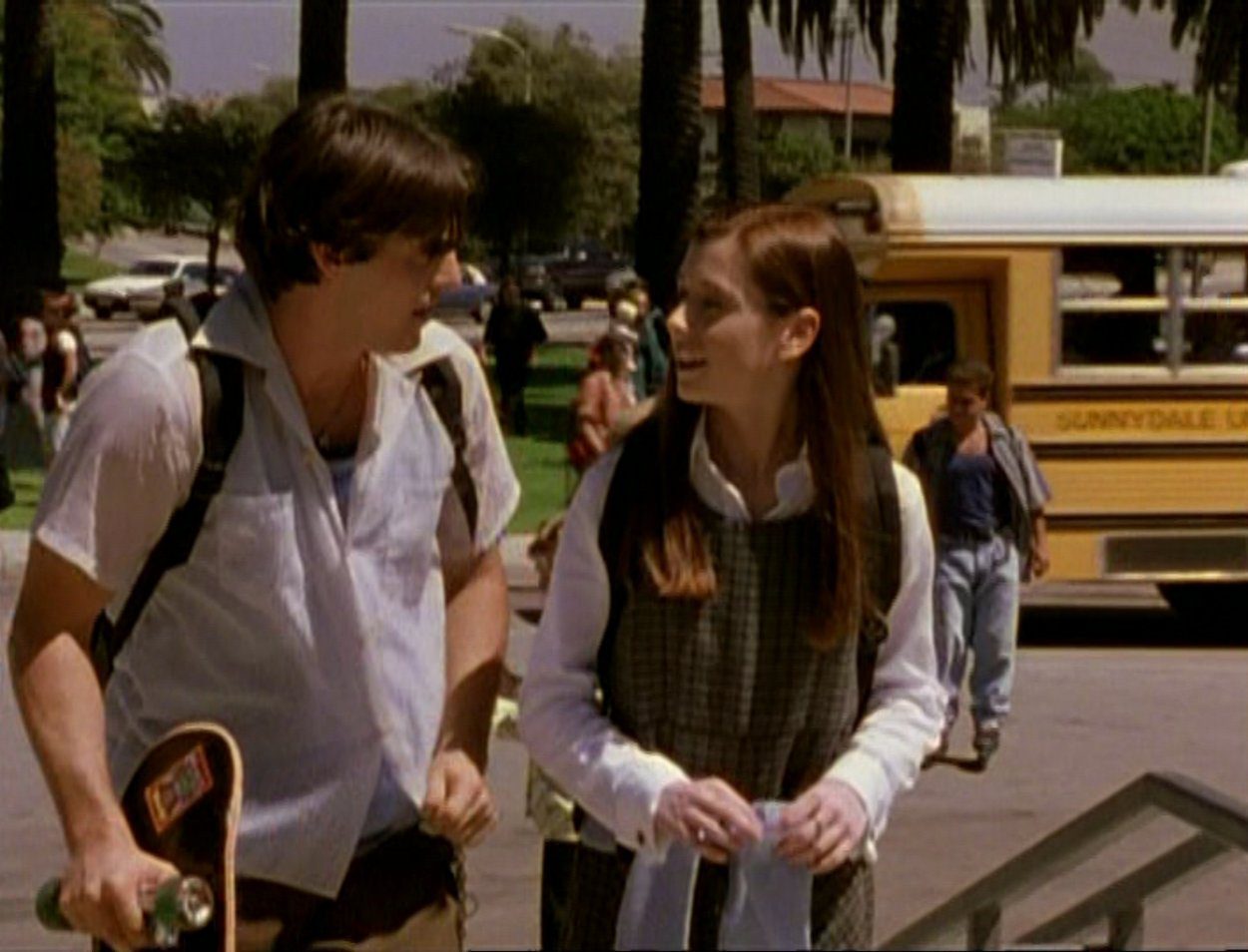
We meet Xander and Willow before Buffy does, and they are instantly loveable and relatable as the school’s losers who nonetheless have each other (and have a lot of fun with their breezy banter and warm affection). They’re joined by Jesse, another loveable loser who completes the trio. Buffy meets Xander when she drops her bag and he awkwardly tries to flirt with her. She later bears uncomfortable witness to Cordelia humiliating Willow, following which Buffy goes out of her way to befriend Willow and ends up happily hanging out with her, Xander, and Jesse. This is cut short when Cordelia shows up to inform Buffy, in her own inimitable way, that “gym was cancelled, due to the extreme dead guy in the locker!”
During the course of her day, Buffy heads to the school library to pick up a book for one of her classes, and there she meets Giles, the sex symbol of my teenage years. For anyone who isn’t into attractive older men, Giles is still a beloved, reassuring presence throughout the series. Unlike Buffy’s mom and teachers—who see her as a bad kid and are constantly disappointed in her for skipping class, sneaking out, and getting into trouble—Giles sees who she truly is: a hero risking her life to save the world. Giles is the person in Buffy’s life who she can always count on, who truly cares about her, and who always knows what to do (or will research it in dusty old volumes until he finds out).
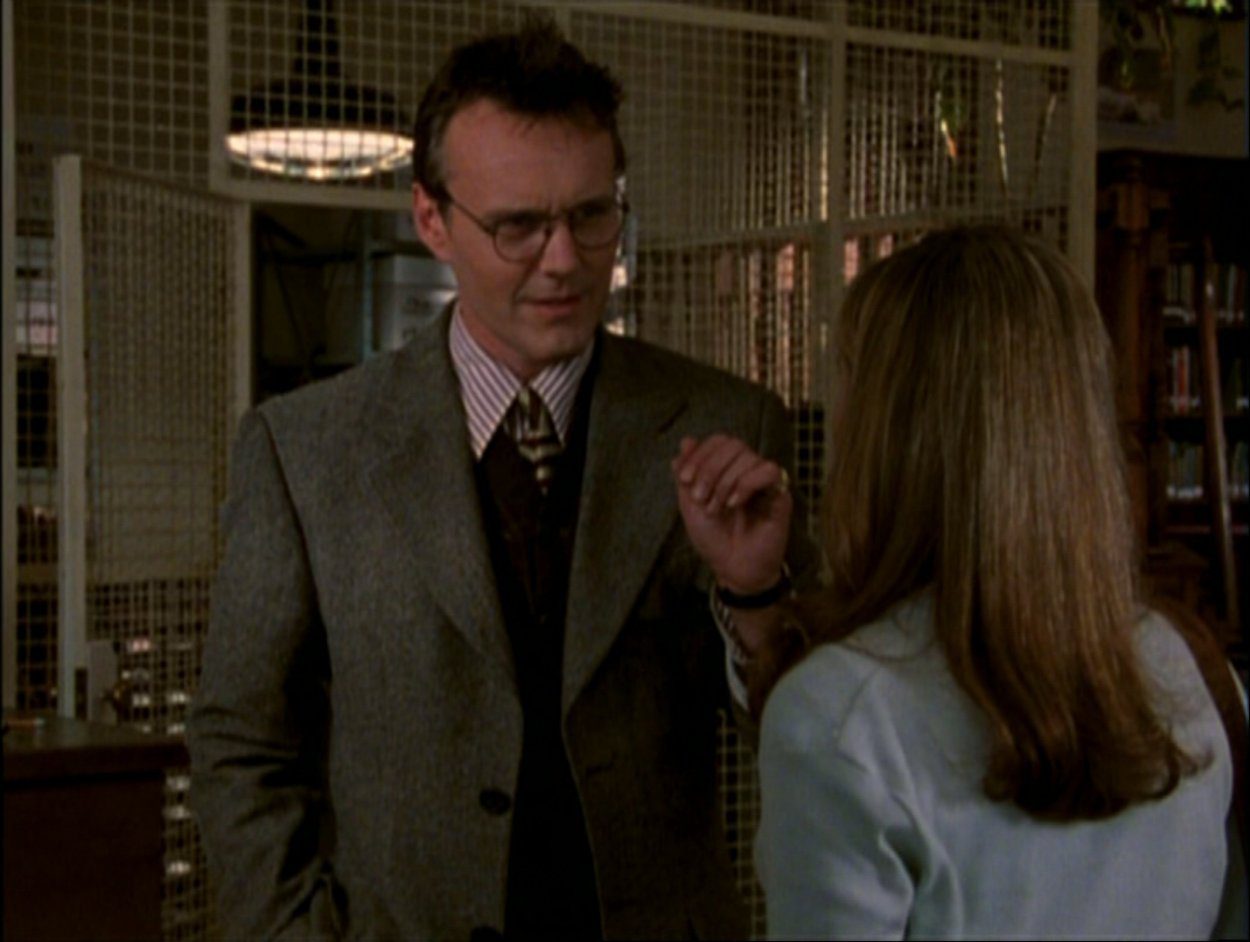
The library itself echoes this sense of reassurance. The set is absolutely beautiful: a cozy room lined with shelves of old books, with a wooden table and chairs in the center. This is the place that Buffy, Giles, Willow, and Xander spend most of their time for the show’s first three seasons, researching mysterious happenings and making plans to fight evil. More than that, it’s a refuge from the stress and cruelty of high school, where none of the teenagers’ fellow students ever show up to bother them. It’s a place they can retreat to when the demons and vampires are kicking their asses, somewhere safe where they can regroup and recharge, somewhere they can bond, talk, and joke together.
The library is a refuge for the audience, too. Watching the show as a teenager, this was the place I retreated to when things in the real world got too tough. I’d constantly watch Buffy, talk to friends about it, think about it, and read about it, escaping from the unpleasant realities of school or whatever else was going on, recharging, and finally finding the strength to go back out there and deal with life.
When Buffy first walks into the library, Giles claims to know what she’s looking for and presents her with a large old tome labeled “VAMPYR.” As well as being the school librarian, Giles is, of course, Buffy’s new watcher, tasked with guiding her in her duties as the slayer, but Buffy wants nothing to do with any of it. Giles spends his first few scenes with Buffy trying to persuade her to change her mind, establishing one of the major themes of the show—that Buffy just wants to be a normal teenager and live a normal teenage life, but as hard as she tries, she can’t escape her destiny.
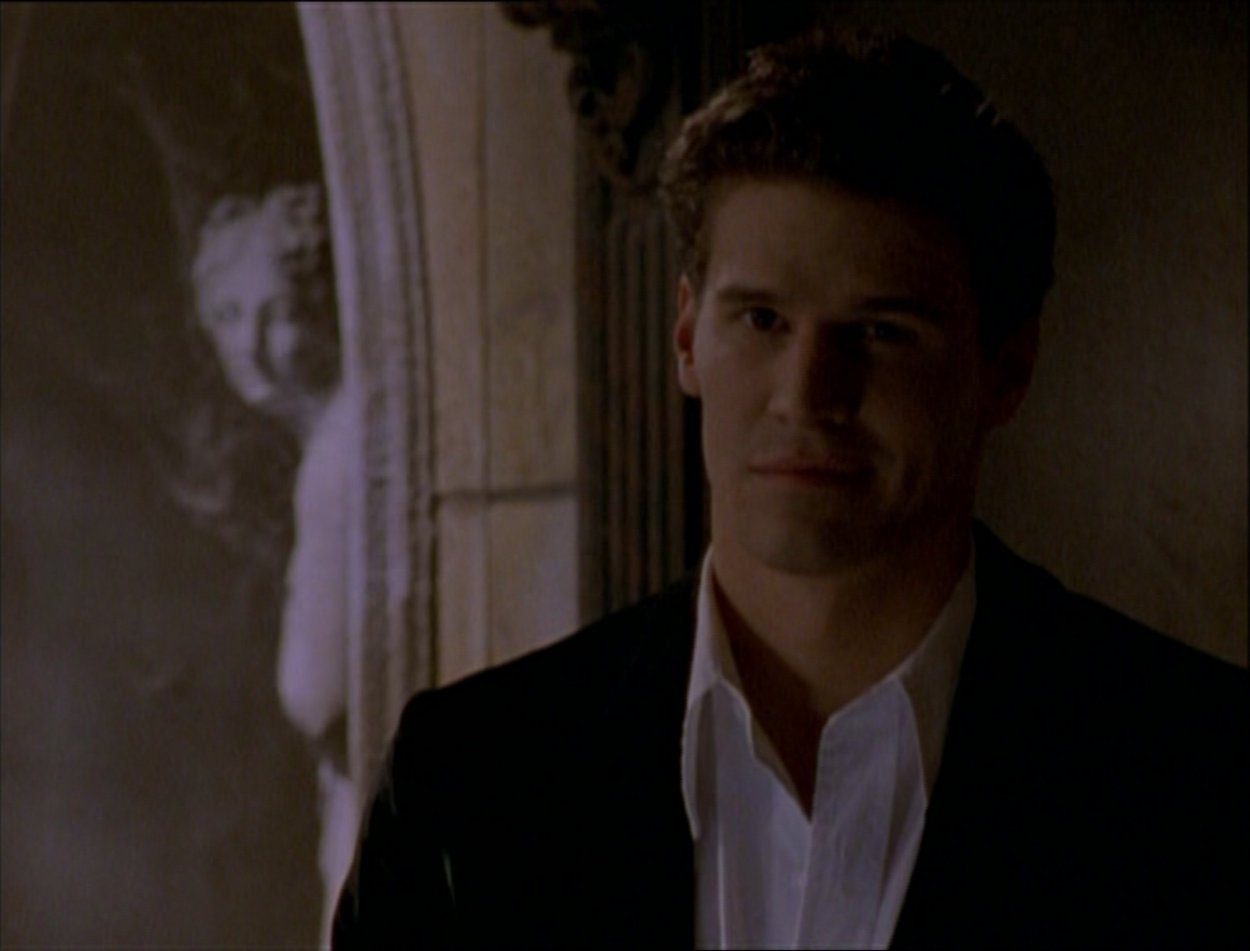
Buffy soon meets another significant figure, Angel, who shows up a few times to give her cryptic hints about the upcoming “harvest.” I always thought it was obvious from the start that Angel was a vampire, but I guess it’s not supposed to be, since that’s made into a big reveal later in the season. Still, he’s mysterious, pale, good-looking, and lurks around in the dark. His presence hints at the romantic and seductive aspects inherent to the vampire myth, which will be a huge part of the show itself.
At the opposite end of the vampire spectrum, we’re introduced to the Master and his minions, most notably Luke and Darla, who are preparing for the harvest. The Master is more of a threatening, classic, Nosferatu-looking vampire, supposedly old enough that his face is permanently twisted, with his fangs on display, ready to feed. He’s the Big Bad for “Welcome to the Hellmouth”/“The Harvest” and for the rest of Season 1. This is hugely important in establishing Buffy as a show about fighting vampires, despite the show rightly branching off to explore other threats more and more as time went on. Vampires would always be at its heart, and the Master was the perfect example.
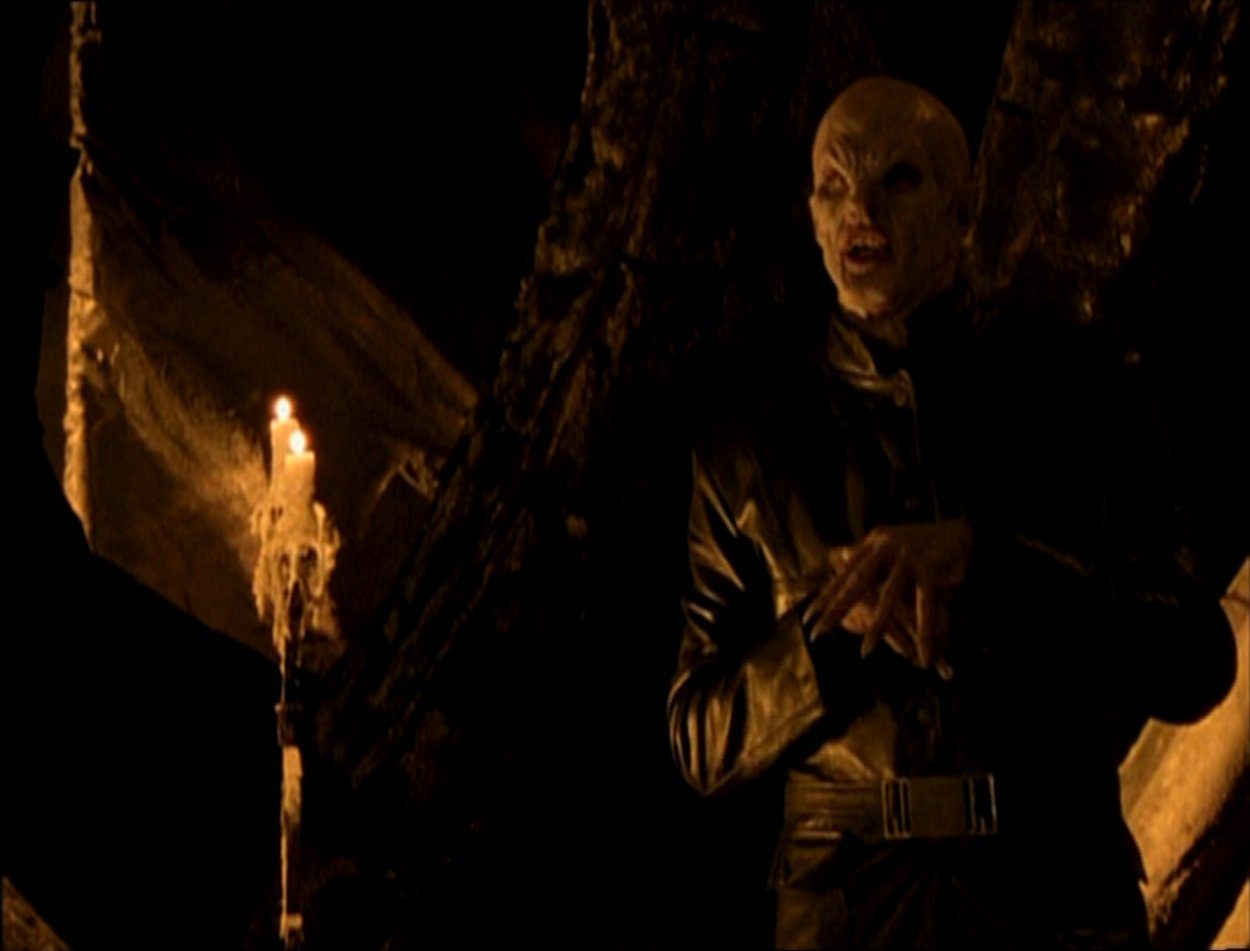
The Master’s lair is instrumental in setting up the aesthetic and style of the show. Its backstory is just as enthralling as the set itself; many years ago, the Master came to Sunnydale and tried to open the Hellmouth that the town sits on, which would effectively end the world. During this process, there was an earthquake, and the Master got stuck “like a cork in a bottle,” trapped in the underground ruins of a church. It’s the ideal gothic setting: underground, but constantly bathed in yellow light from the candles all over the place, bits and pieces of church ruins sticking up at odd angles wherever you turn, pools of blood or water (or both?) scattered about the rocky ground. Contrasting with the above-ground scenes of sunny California and the cozy library, the Master’s lair helps to highlight the central dichotomy of the show—the strange mixture of teenage life and vampire slaying.
Back to the teenage life part—at the end of Buffy’s first day of school, she gets ready to head to a local club, The Bronze. She tells her mom this, leading to this classic exchange:
Joyce: “Oh. Will there be boys there?”
Buffy: “No, Mom, it’s a nun club.”
Yet again, the set designers knock it out of the park with The Bronze—another location that would become a vital part of the show’s identity. The atmosphere is perfect, with fairy lights strung around the place, tables to sit at, a dancefloor and stage, plus plenty of dark corners to explore. The music is always cool but obscure enough that you’ve never heard it before, and just like the library, The Bronze feels like a home away from home for the show’s characters and viewers alike.
From here, events conspire for Buffy, Willow, Xander, and Giles to quickly bond and start to trust each other, for Willow and Xander to learn that Buffy is the slayer, and for Buffy to change her mind about her current reluctance to fight vampires. In the perfectly structured sequence, Buffy advises Willow to seize the moment, “because tomorrow you might be dead!” She then joins Giles on the balcony, and he challenges her to look for vampires. She spots one (due to his outdated clothes, rather than the sensing method Giles wants her to use), heading out with Willow, who is, of course, seizing the moment. There’s a brief interlude during which Buffy puts the final nail in the coffin of her social life by mistakenly attacking Cordelia with a stake (cue the classic Cordelia line, “Excuse me, I have to call everyone I’ve ever met, right now!”).
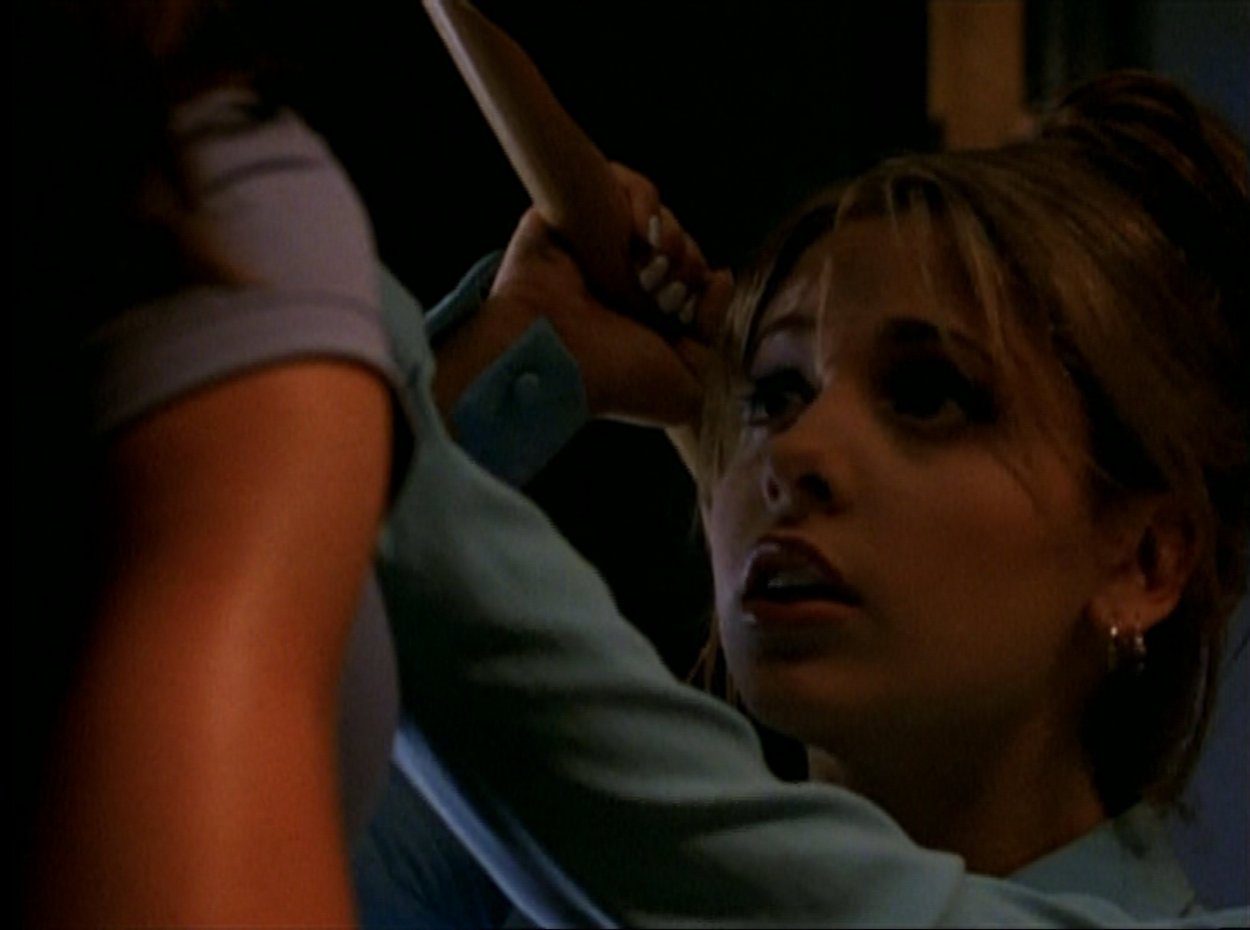
Buffy then runs into Xander outside The Bronze, as she frantically looks for Willow. Xander follows her, and they end up in a mausoleum where Willow and Jesse are being held by Darla and the vampire with the outdated clothes. Luke also shows up, and a fight ensues. In the end, Buffy saves Xander and Willow from the vampires (staking a couple in front of them in the process), but Jesse is gone, taken by the vamps.
Xander and Willow can’t deny what they’ve witnessed, and the next day in the library, Buffy and Giles fill them in on the details of vampire slaying. Desperate to find Jesse, Buffy heads down to the electrical tunnels underneath the city, while Giles researches the harvest in his books and Willow researches online. Xander hates feeling useless and catches up with Buffy in the tunnels, desperate to help despite everyone warning him to stay out of danger.
Through this reasonably short sequence, the Scooby Gang have become a unit, and they’re already starting to fit into their individual roles: Buffy as the slayer, Giles doing book research, Willow doing computer research, and Xander being useless but wanting to help. That may sound like a bad role for Xander, but I believe it’s actually pretty important throughout the series. He’s kind of like the outcast among outcasts, which a lot of people have felt like before. Sometimes, when you’re feeling down, you can’t relate to being a slayer, or a watcher, or anyone with special powers. Sometimes you need a character to relate to who doesn’t know if they’re good enough but who just wants to try their best. This theme is addressed in depth in several Xander-centric episodes over the show’s run, including “The Zeppo” and “Potential,” when he uses his experiences to comfort Dawn, who’s also feeling this way.
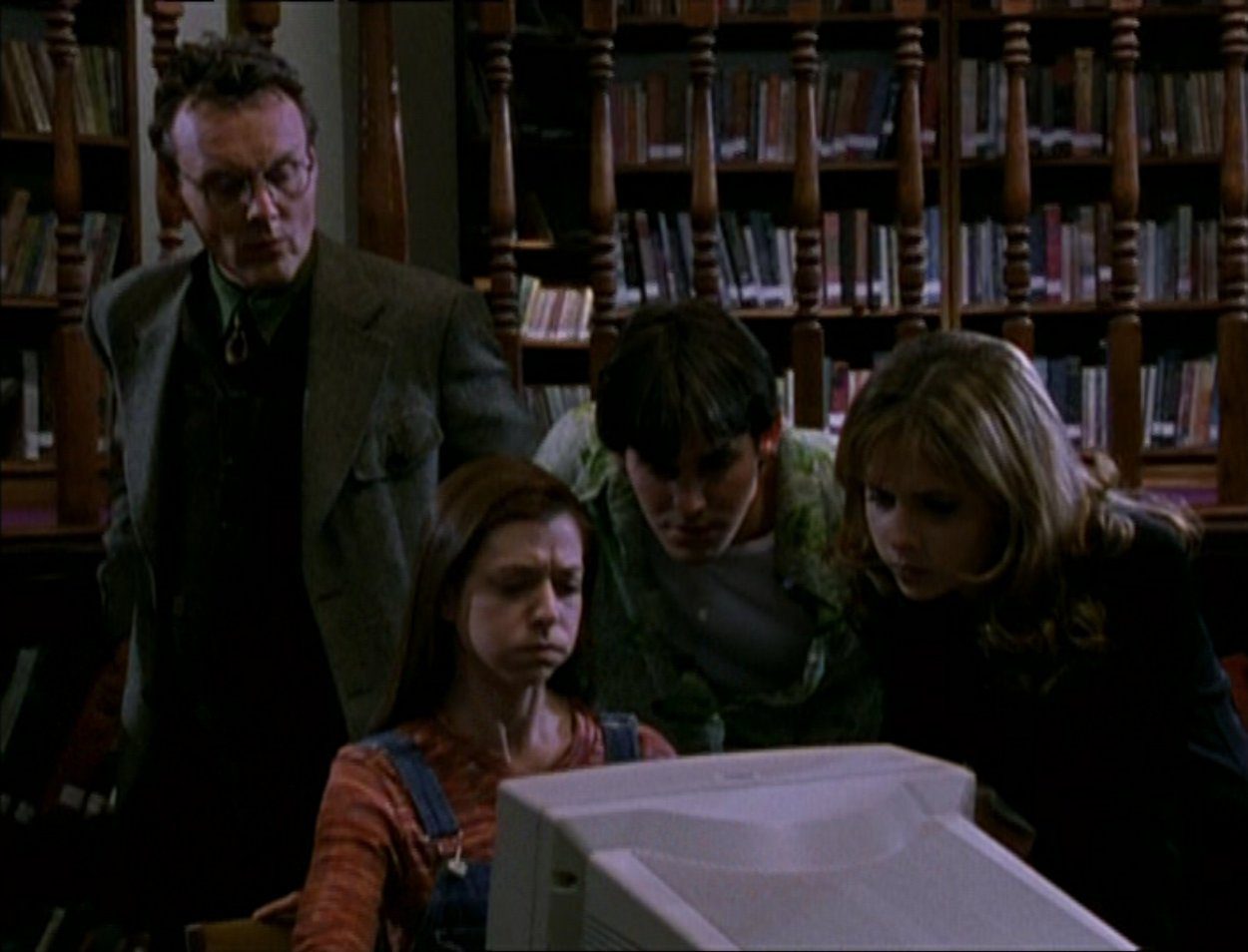
During Buffy and Xander’s near-fatal trip through the tunnels, it’s revealed that Jesse has been turned into a vampire. Even though Jesse was clearly written into the show to be killed, it still has a huge impact to introduce him as part of the main friendship group and then kill him off. We may not have gotten to know him well, but it still packs an emotional punch, as well as raises the stakes and establishes that on Buffy, no one is ever safe.
For a while, Xander talks about vamp Jesse as if he’s still the same person that he knew. Eventually, Giles delivers a great dramatic line to Xander that simultaneously offers some exposition about the show’s vampire lore: “You have to remember that when you see him, you’re not looking at your friend. You’re looking at the thing that killed him.”
Giles and the gang finally figure out what the harvest is—the Master will perform a ritual, which is only possible once every century, to make Luke into his vessel. Luke and the other vampires will go to The Bronze, where Luke will feed on as many people as possible, and their energy will be transferred to the Master until he’s powerful enough to break free from his underground prison. This will also open the Hellmouth and destroy the world. The harvest is a big, apocalypse-level threat. It feels epic—the right scale to start the series off.
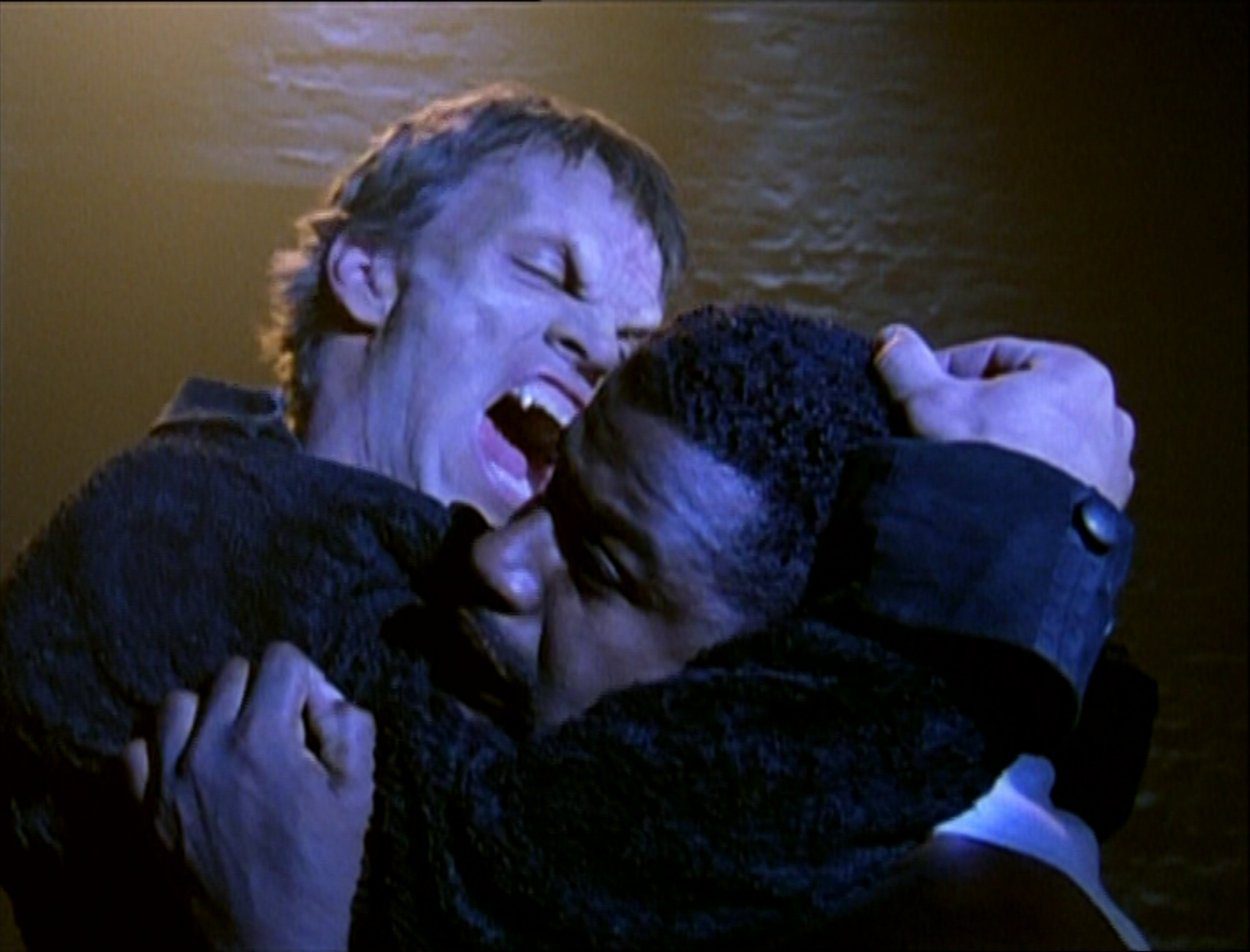
Buffy still has to deal with everyday teenage problems, as Joyce grounds her for cutting class, forcing Buffy to sneak out. The Scoobies head to The Bronze and find the vampires already there. Giles, Willow, and Xander try to get everyone out while Buffy fights Luke, and the gang simultaneously tries to fend off the rest of the vampires. During the ensuing chaos, Buffy memorably decapitates a vampire with a cymbal while Xander hesitates to stake Jesse. He ends up accidentally doing it anyway when Jesse is pushed towards him, and the stake Xander is holding is driven into Jesse’s heart.
After a tough fight, Buffy eventually manages to distract Luke by telling him that he forgot about sunlight, then smashing a window. As Luke cowers and tries to hide from the streetlight that streams in, Buffy reminds him that “it’s in about nine hours, moron,” and finally stakes him. After this, the remaining vampires take one look at Buffy and run. The world is saved, for now.
The next day at school, Willow and Xander wonder why no one else seems to remember what happened. Buffy and Giles, used to this phenomenon, explain that people tend to rationalize what they can and forget what they can’t—something which will happen a lot throughout the series, despite Xander’s protests: “I mean, the dead rose! We should have at least had an assembly.”
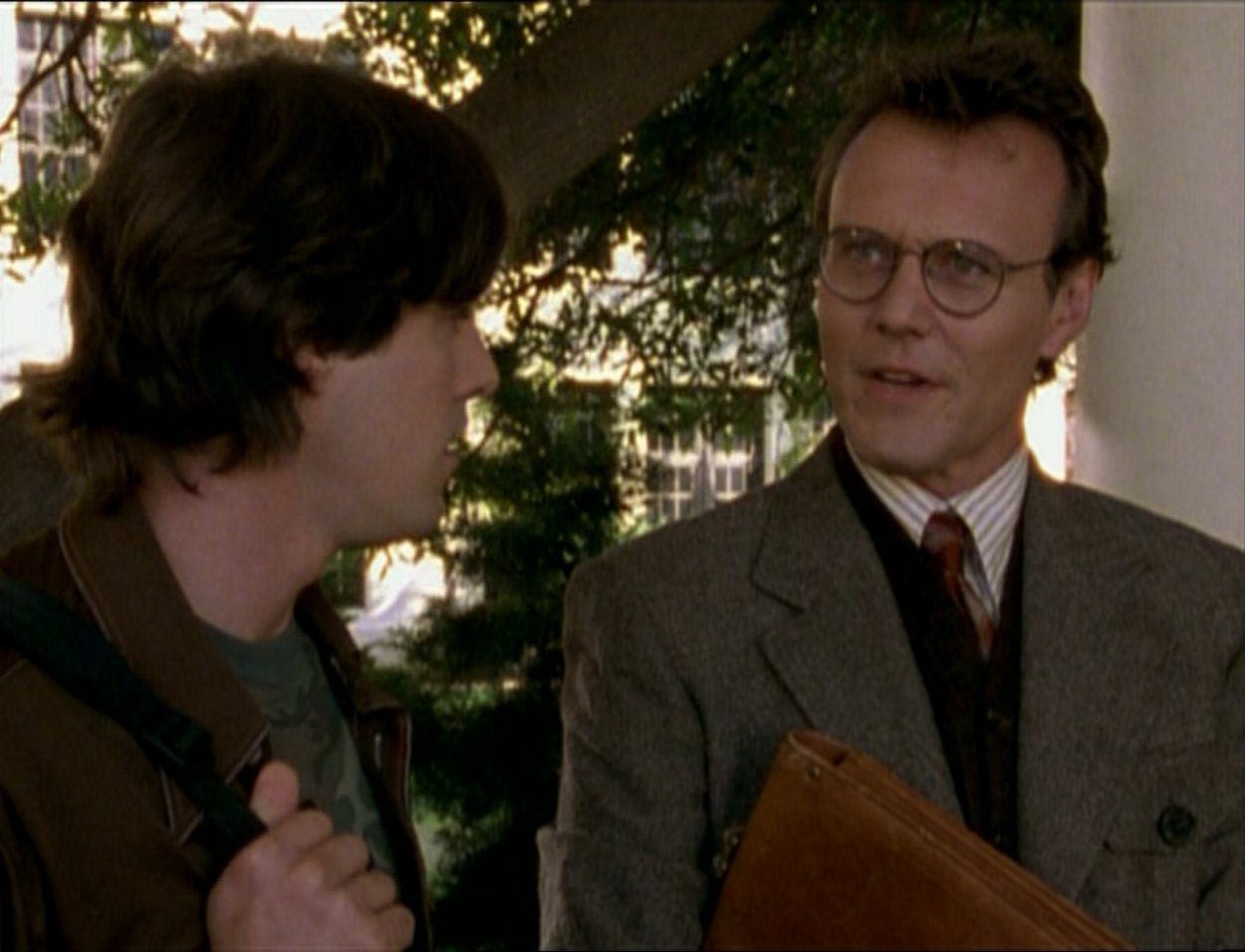
As the episode draws to a close, Giles tells Buffy, Willow, and Xander, “We may, in fact, stand between the Earth and its total destruction.” As the teenagers wander off, joking about how Buffy could still get kicked out of school, Giles delivers the classic line that ends the episode: “The Earth is doomed.” On my most recent rewatch, I waited for this line, thinking that it’s a little cheesy, but when it came, I was surprised to find it actually made me cry—because this was the start of everything. How can you not love the Scoobies after this? How can you not want to see what the Master does next? How can you not want to see who’s going to be playing at The Bronze? This is about as perfect as a pilot gets, and the series that follows lives up to its promise phenomenally.

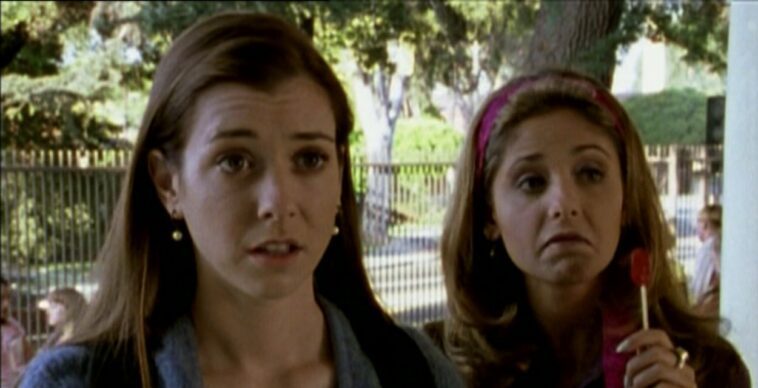
I highly recommend the Frasier pilot for this series. one of the most fully formed and amazingly strong pilots ever made.